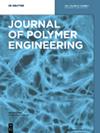泡沫注射成型过程中的塑化对长玻璃纤维增强聚丙烯的熔体粘度和纤维长度的影响
IF 1.7
4区 工程技术
Q4 POLYMER SCIENCE
引用次数: 0
摘要
长玻璃纤维增强热塑性塑料在加工过程中,尤其是在塑化过程中,会造成严重的纤维损伤。通过使用发泡剂气氛恒定的热塑性泡沫注塑成型(FIM),可减少塑化过程中的纤维损伤。这一方面可归因于熔体粘度的降低,另一方面可归因于熔化行为的影响。因此,我们分析了 FIM 和工艺参数对纤维长度和纤维长度分布的影响,并与工艺参数对熔体粘度的影响进行了比较。本文章由计算机程序翻译,如有差异,请以英文原文为准。
Influence of plasticisation during foam injection moulding on the melt viscosity and fibre length of long glass fibre-reinforced polypropylene
The processing of long glass fibre-reinforced thermoplastics results in considerable fibre damage, particularly during plasticising. By using thermoplastic foam injection moulding (FIM) with a constant blowing agent atmosphere, fibre damage during plasticisation can be reduced. This can be attributed to the reduction of the melt viscosity on the one hand and the influence of the melting behaviour on the other. Therefore, the influence of the FIM and the process parameters on the fibre length and the fibre length distribution are analysed and compared with the influence of the process parameters on the melt viscosity.
求助全文
通过发布文献求助,成功后即可免费获取论文全文。
去求助
来源期刊

Journal of Polymer Engineering
工程技术-高分子科学
CiteScore
3.20
自引率
5.00%
发文量
95
审稿时长
2.5 months
期刊介绍:
Journal of Polymer Engineering publishes reviews, original basic and applied research contributions as well as recent technological developments in polymer engineering. Polymer engineering is a strongly interdisciplinary field and papers published by the journal may span areas such as polymer physics, polymer processing and engineering of polymer-based materials and their applications. The editors and the publisher are committed to high quality standards and rapid handling of the peer review and publication processes.
 求助内容:
求助内容: 应助结果提醒方式:
应助结果提醒方式:


